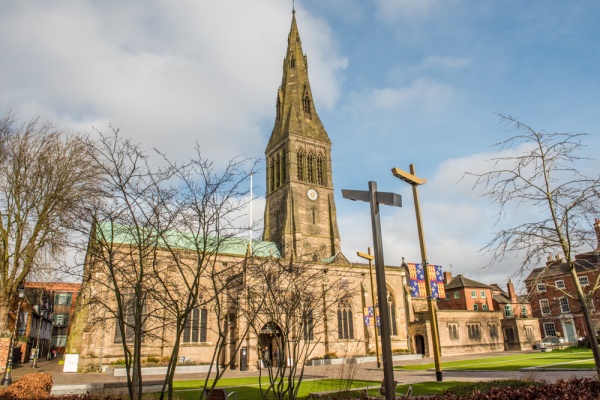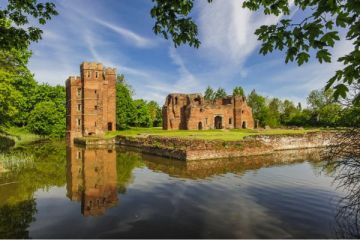
Leicester Cathedral has been a place of worship for at least 900 years, but has been a cathedral only since 1927. The cathedral began as a simple parish church dedicated to St Martin, and was raised to cathedral status in the 20th century.
History
The story of Leicester Cathedral has its beginnings in AD 680, when Cuthwine was named the first Bishop of Leicester. Around 870 the invading Danes invaded the Midlands and the last Saxon Bishop of Leicester fled their advance. Leicester ceased to be a separate diocese and was absorbed into the diocese of Lincoln.
The first record of St Martin's church comes in the Domesday Book of AD 1086, when it was one of six churches in Leicester. When Leicester Abbey was founded in the early 12th century all the churches of Leicester were given to the Abbey, and the monks appointed the vicar of St Martins.
The church was rebuilt and enlarged in the 13th century, and again in the 15th century when the nave and aisles were extended. During the medieval period, St Martin's became the civic church, used by the city guilds that administered civic business from the timber-framed Guildhall immediately beside the west end of the church.

During the Reformation the interior of the church was stripped of its statues, screens, and stained glass.
In 1757 the present slender spire was added atop the medieval tower. Both tower and spire were completely rebuilt from 1860.
Cathedral Highlights
You enter the cathedral through a richly carved south porch, decorated with statues of seven people closely connected to the history of Leicester, including St Guthlac, Bishop Hugh of Lincoln, and religious reformer John Wycliffe.
In the sanctuary is the cathedra, or Bishop's throne, carved with a figure of St Martin on horseback. Over the altar is the huge east window, filled with colourful stained glass commemorating the dead of WWI.
In the north-east corner of the church is the Herrick Chapel, dedicated to St Katherine. Above the chapel altar is a stained glass window depicting Robert Herrick, the 17th century poet who also served as a church rector in Devon.

Near the south door is St George's Chapel, once the chapel of the Guild of St George. One of the windows depicts the saint killing a dragon. The chapel is home to a memorial honouring the Royal Leicestershire Regiment, and battle honours won by the regiment hang from the chapel screen. The regiment was known as 'The Tigers' and their name lives on in the Leicester Rugby Football Club, founded by officers of the regiment.
In the north aisle is a memorial to Sir John Whatton, High Sheriff of Leicestershire and a friend of King Charles I. The king visited Whatton on several occasions and worshipped in St Martins church at least twice.
Near the south doorway are several beautifully carved wooden figures showing people with various physical ailments, such as a hunched back. These figures are echoed with more modern replicas acting as corbel; heads supporting the roof above. They were presumably meant to remind worshippers that Christ healed the ill and infirm. Look for a Green Man figure supporting one of the painted corbel statues.

Richard III's Tomb
Most people are drawn to Leicester Cathedral by its link to Richard III. The 'King in the Car Park' died at the Battle of Bosworth in 1485 and was brought to Leicester for burial. He was buried at Greyfriars Priory which stood beside St Martins. After the Priory was destroyed following the Dissolution of the Monasteries the site of Richard's grave was lost, and a legend spread that his bones had been dug up and scattered in the River Soar by Bow Bridge.
In 2012 King Richard's remains were discovered under a council car park just a stone's throw from the cathedral. There was a great deal of discussion over what should be done with the king's skeleton, and the final decision was to rebury him in Leicester Cathedral. Richard's body was reinterred in an event watched by television viewers around the world in 2015. To mark his grave a new memorial was created by the architects van Heningen and Haward.
The tomb stands in the ambulatory between the high altar and the Chapel of Christ the King at the east end of the church. The tomb is shielded from the main body of the church by a richly cared 19th-century screen. The tomb is made of a single block of white Swaledale stone from Yorkshire, atop a polished slab of Kilkenny marble.
The white stone is deeply carved with a cross, allowing light to flood through the slab. Richard's remains lie beneath the tomb in a lead ossuary encased in a coffin of English oak. The coffin is set within a brick-lined vault sealed by the tombstone above.

In 1980 a memorial slab dedicated to Richard III was set into the chancel floor. The 'Richard III Stone' is now on display in the Richard III Centre directly opposite the cathedral. It was removed when the king was reburied in the cathedral in 2015.
The iconic statue of Richard III that once stood in Castle Gardens was moved to a new location in the Cathedral Gardens, near the entrance to the newly built Richard III Centre.
At the west end of the church is a display case containing the funeral pall and the crown used during Richard III's reinterment. The crown is a replica of a medieval crown of the sort Richard would have worn on ceremonial occasions, set with semi-precious stones and pearls.
The cathedral is open regularly to visitors and is free to enter, though you are requested to make a donation. It is well signposted around central Leicester.
About Leicester Cathedral
Address: Peacock Lane,
Leicester,
Leicestershire,
England, LE1 5DE
Attraction Type: Cathedral
Location: Beside the Guildhall and directly opposite the Richard III Centre.
Website: Leicester Cathedral
Location
map
OS: SK584044
Photo Credit: David Ross and Britain Express
HERITAGE
 We've 'tagged' this attraction information to help you find related historic attractions and learn more about major time periods mentioned.
We've 'tagged' this attraction information to help you find related historic attractions and learn more about major time periods mentioned.
Find other attractions tagged with:
NEARBY HISTORIC ATTRACTIONS
Heritage Rated from 1- 5 (low to exceptional) on historic interest
Leicester Guildhall - 0 miles (Museum) ![]()
Richard III Centre - 0.1 miles (Museum) ![]()
Wygston's House - 0.1 miles (Historic Building) ![]()
Leicester High Cross - 0.1 miles (Historic Building) ![]()
Leicester, St Nicholas Church - 0.2 miles (Historic Church) ![]()
Jewry Wall, Leicester - 0.2 miles (Roman Site) ![]()
Leicester Clock Tower - 0.2 miles (Historic Building) ![]()
The Magazine - 0.2 miles (Historic Building) ![]()
Nearest Holiday Cottages to Leicester Cathedral:
East Norton, Leicestershire
Sleeps: 4
Stay from: £415 - 1418
More self catering near Leicester Cathedral











